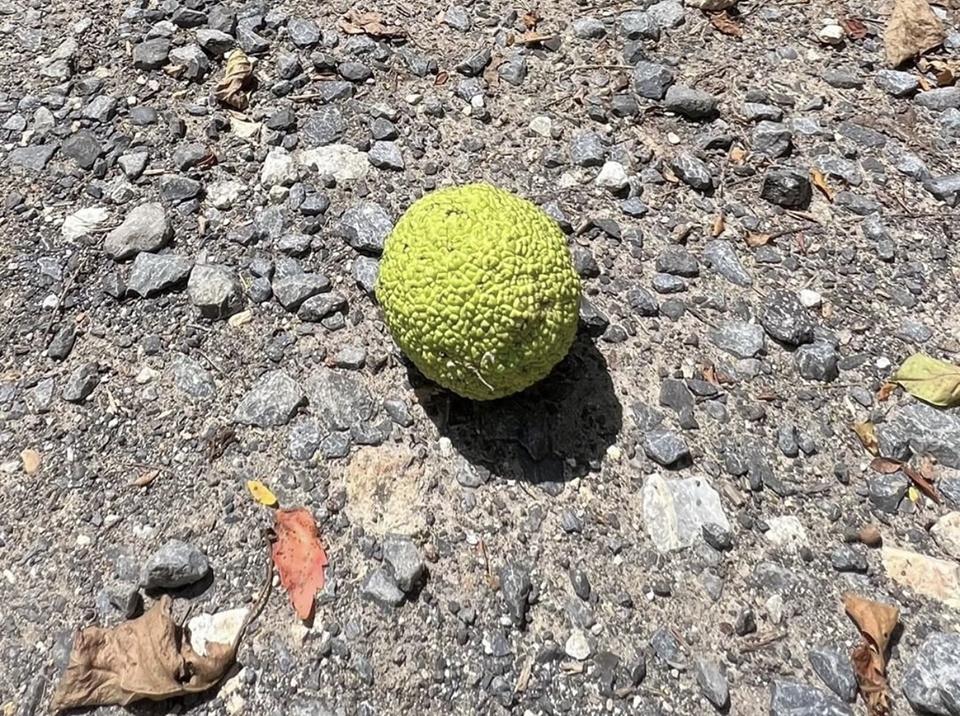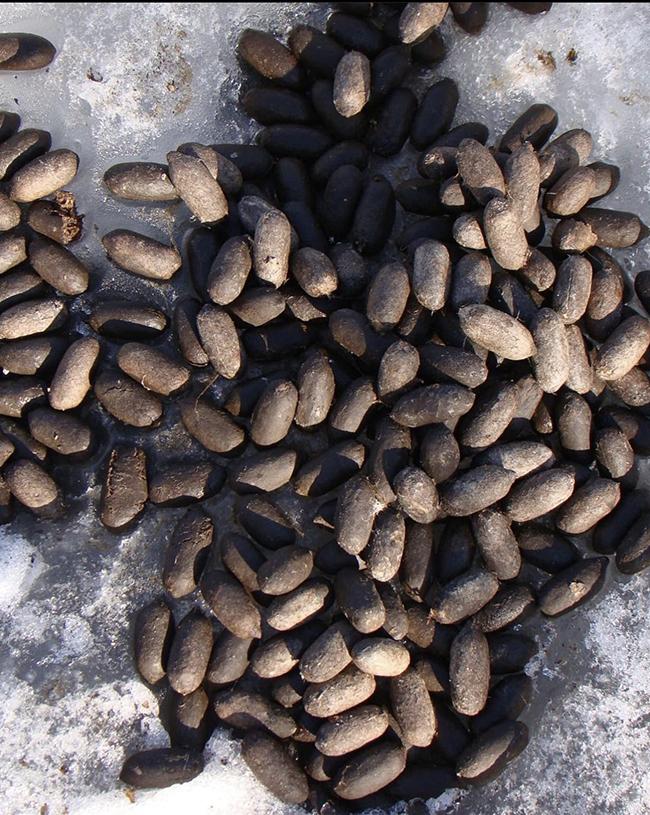
Who are you lookin' at? Yosemite National Park / Rebecca Latson
It’s September, so that means it’s time for your next monthly national park quiz and trivia piece. Just how well do you know the units within the National Park System? Test your knowledge before looking at the answers at the bottom of this piece. Maybe you’ll have learned something new.
1. Canyonlands, Petrified Forest, and Yosemite national parks are just some of the park units in which you might see a raven. In addition to their raspy caw, ravens have up to ___ different vocalizations.
a) 17
b) 23
c) 34
d) 41

Hike around Buffalo National River and you might come upon this odd little fruit / NPS
2. While hiking at Buffalo National River in Arkansas, you might come across this interesting little “freaky fruit” seen in the image above. This fruit comes from the _____ tree.
a) American Chestnut
b) Osage Orange
c) Ozark Chinquapin
d) Sweetgum

Bog orchid, North Cascades National Park / NPS
3. The image above is a bog orchid. You might see them while hiking in North Cascades National Park. True or False: bog orchids imitate the scent of humans to lure mosquitoes.
a) True
b) False

A Mexican free-tailed bat, Bandelier National Monument / NPS
4. How many species of bats have been found at Bandelier National Monument?
a) 11
b) 12
c) 13
d) 14

Mmmm! What is this tasty-looking little berry called? Glacier Bay National Park and Preserve / NPS
5. While exploring parts of Glacier Bay National Park and Preserve you might come across these little berries, which are called ___.
a) Marionberries
b) Salmonberries
c) Raspberries
d) Thimbleberries

A Trans-Pecos Striped Whiptail, Big Bend National Park / NPS - CA Hoyt
6. The Trans-Pecos Striped Whiptail, pictured here, is the smallest of the ___ species of whiptails found in Big Bend National Park.
a) Four
b) Five
c) Six
d) Seven

Big Balanced Rock, Chiricahua National Monument / NPS
7. Have you ever visited Big Balanced Rock at Chiricahua National Monument in Arizona? While it looks like a breath of wind could topple it, a rock like this would “typically need a push of 12 to 13 times its own weight in sheer force.” The type of rock that makes up a vast majority of [Chiricahua’s] stunning rock formations is ___.
a) Diorite
b) Rhyolite
c) Andesite

What pooped in the park? Kenai Fjords National Park / NPS - Don Dunham
8. “Identifying scat [poop] in a park can be helpful by letting you know what wildlife you could potentially encounter on the trail. It will also indicate if you should be even more observant (where you step) if you see scat from a specific species that could potentially become aggressive if approached.” The pile of scat in the image above photographed at Kenai Fjords National Park was left by what animal?
a) Moose
b) Black bear
c) Raccoon
d) Rabbit

A green lynx spider and her babies, Saguaro National Park / NPS - Nic Perkins
9. While hiking a trail at Saguaro National Park, you spot a bit of color on a plant. You bend in or a closer look and see a green lynx spider surrounded by her babies. What is a group of baby spiders called?
a) Nightmare cluster
b) Spiderling cluster
c) Spiderlet cluster
d) Moltling cluster
10. “When you visit Voyageurs National Park, you might think you are getting away from it all. In truth, you are entering a large urban population of beavers.” True or False: beavers are North America’s largest rodent.
a) True
b) False
Trivia

Indian pipe / ghost pipe / corpse plant, Beaubears Island Shipbuilding National Historic Site / Jennifer Bain
These “translucent, ghostly wildflowers” you see in the image above are known as Indian pipes, ghost pipes, or corpse plants. Monotropa uniflora does not possess chlorophyll to produce that green color you usually see in vegetation, nor does it use photosynthesis to produce food. Instead, this unique wildflower has a parasitic relationship with certain types of fungi to obtain nutrition. First Nations people used the Indian pipe for medicinal purposes such as treating eye infections, toothaches, and as an anticonvulsive. It’s “widely found in shaded woods across North America,” such as on Beaubears Island in the Canadian province of New Brunswick.

A buckskin map, Big Hole National Battlefield / NPS
“On August 9th, 1877 … five bands of the nimí·pu· (Nez Perce) and their allies slept in the [Big Hole Valley] until they were awakened in the middle of the night by the sound of a single rifle shot. Once the stillness of the night was broken, the 7th infantry opened fire upon the nimí·pu· teepees and proceeded to charge the camp. The fate of the 800 nimí·pu· looked dim but a rousing speech from leaders ?elelímyete?queniń (Looking Glass) and lama·tá (White Bird) gave the nimí·pu· a fighting chance. They were able to push the 7th infantry back into the trees and pin them in the siege area for a little over a day. After the smoke cleared and the dust settled, the nimí·pu· realized what they had lost. Sixty to ninety nimí·pu· were killed during the battle. Women, children, elders, and warriors had all fallen during the attack. Colonel Gibbon, the leader of the 7th infantry, took significant losses as well. Thirty-one of his men were killed and an additional 38 were wounded. Once the Flight of 1877 ended, the Battle of the Big Hole would be recognized as the bloodiest battle that occurred during the flight.”

Devils Tower formation theories, Devils Tower National Monument / NPS
Other ideas have suggested that Devils Tower is a volcanic plug or that it is the neck of an extinct volcano (lower left figure). The limited evidence of volcanic activity (volcanic ash, lava fows, or volcanic debris) in the area creates doubt that the Tower was part of a volcanic system. It is possible that this material may simply have eroded away. In 2015, geologist Prokop Závada and his colleagues proposed their own hypothesis for the formation of the Tower. They compared it to a similar butte formation in the Czech Republic. Their hypothesis suggests that the Tower is the result of a maar-diatreme volcano (lower right figure). These form when magma encounters groundwater beneath the Earth’s surface. The super-heated water becomes steam. This steam expands explosively creating a crater on the surface. The crater fills with lava which cools and solidifies into a dome structure. Erosion wears away portions of the dome to create the Tower as we see it today.
The concept of erosion exposing the Tower is common to all of its modern formation theories. Ironically, the erosion that exposed the Tower also erased the evidence needed to determine which theory of Devils Tower’s formation is the correct one.
Quiz Answers
1c
According to the NPS, ravens have up to 34 different vocalizations, including knocking, clicking, rasping, and croaking. They can also imitate other birds, mimic manmade sounds, and learn human words when raised in captivity. Ravens belong to the genus Corvus, are very intelligent, possess problem solving abilities and have an understanding of cause and effect. They’ve even been known to unzip hikers’ backpacks to get to the goodies within.
2b
That freaky little fruit comes from the Osage Orange tree at Buffalo National River. It’s considered inedible to humans, but “the small seeds inside are favorites of squirrels and deer." The tree, itself, was “dubbed by early French explorers ‘Bois d’arc’ as a reference to the bows made by the Osage tribe.” To learn more about the trees and shrubs found within this national river area, click here.
3a True
Sounds crazy enough to be true, right? And it is. According to the NPS, “a 2020 study found that many of the chemicals found in the blunt-leaf bog orchid are also present in human body odor. Additional studies linked the common chemicals shared by the blunt-leaf bog orchid and human body odor to the specific scent compounds favorited by mosquitoes."
4c or 4d
Hmmm, was this a trick question? Why two answers? According to an Instagram post by Bandelier National Monument, fourteen species of bats have been found within the monument, “living in caves or frequenting the parks as their hunting grounds." According to the NPS website for Bandelier, thirteen species of bats live within this national monument. Maybe the difference in numbers is related to just bats that live within the national monument vs. an additional bat that frequents the national monument to bring the number up from thirteen to fourteen. To learn more about bats found at this national monument, click here.
5d
“The thimbleberry flower is a unique native plant to the Western region of the United States. The plant boasts clusters of sweet red fruits, white star-shaped flowers, and huge velvety maple-like leaves. Thimbleberries ripen from late June to August, turning from a pale pink to scarlet, and have a sweet yet tart taste … Thimbleberries are rich in vitamin C and have healing properties that have been known to treat scurvy.”
6a
The Trans-Pecos Striped Whiptail is the smallest of the four species of whiptails found in Big Bend National Park. They are constantly on the move “but will only run a short distance before getting distracted [squirrel!] by the possibility of something to eat.” To read more about lizards found in this national park in Texas, click here.
7b
Rhyolite, a silica-rich, extrusive volcanic rock, makes up the majority of the rock formations you’ll see at Chiricahua National Monument. If you look closely at a rhyolite rock formation, you’ll notice that the mineral grains composing this rock are very, very, small. That’s because rhyolite is a rock formed by quick cooling above ground (the extrusive part). To learn more about the geologic formations found within this national monument, click here.
8a
Moose scat is shaped like oval pellets. Moose need to eat about 50–60 pounds of food per day to survive. That translates to quite a bit of poop!
9b
While it might indeed be a nightmare to see this image in real life (depending upon how you feel about spiders), a group of baby spiders is called a spiderling cluster. Oh, and FYI regarding the green lynx spider, they don’t have much use for webs, instead “spending their lives as hunters on plants … and they can spit venom nearly eight inches.”
10a True
Beavers are North America’s largest rodent, according to the NPS. “Once coveted for their valuable fur, used to turn into fashionable hats, beavers were overtrapped and nearly extirpated … by the early 1900s. Today, the highest density of beavers in the U.S. can be found in the protected waters of Voyageurs – about 3,800 to 4,750 based on 948 active beaver lodges found in a recent park study." To read more about beavers in this national park, click here.




 Support Essential Coverage of Essential Places
Support Essential Coverage of Essential Places






